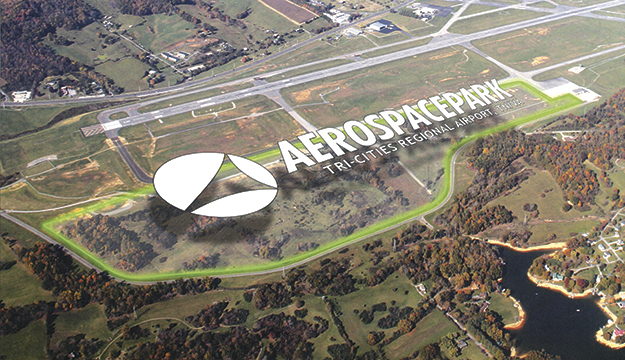Photo above: A marketing map of Aerospace Park made when TCA was still TCRA
By Scott Robertson
When Tri-Cities Airport (TCA) Executive Director Patrick Wilson finished showcasing the facility’s new electric-powered tug and baggage conveyor Dec. 20, he was wrapping up a busy year. Only days before, Wilson had hosted a news conference announcing the rebranding of what had, since 1937, been the Tri-Cities Regional Airport. The airport also relaunched its triflight.com website. And in August, the airport reopened its newly rescaped parking area.
Both in public and behind the scenes, 2016 was a positive year for TCA. The airport authority, though, believes 2016 was just a stepping stone. This time next year, Wilson hopes the positive changes that will have occurred at the airport will dwarf the impact of 2016.
Awakening the sleeping giant
One of the first items on the agenda, and certainly the one with the greatest possible long-term impact on the region, will happen not in Blountville, but in Nashville during the deliberations of the Tennessee General Assembly. State legislators will consider making a change in the wording of a state act that might allow the airport’s surrounding communities to bond necessary site work on the Aerospace Park initiative.
Aerospace Park is the brand the airport authority has given to its attempt to turn 160 acres of fallow ground on the far side of the main runway from the terminal into an industrial park for aerospace cluster businesses. The park would leverage not only the fact that the land represents the only Select Tennessee Certified development with direct airfield access, but also its proximity to Northeast State Community College for workforce training, a foreign-trade zone and on-site Customs.
Community leaders and economic development officials have expressed enthusiastic support for the site’s development because the aerospace cluster generally creates high-paying jobs and significant capital investment. “I love the concept and like the opportunity,” said State Representative Timothy Hill. “You’re talking about a crossroads scenario. What do we want to be and what can we be? The types of jobs that are proposed to go into this place are not retail. They’re economy-sustainers.”
The hold-up in developing the property to date has been the need for grading 140 of the 160 acres. In 2016, Wilson told The Business Journal it would cost around $15 million to cover the cost of that work.
Bristol, Kingsport, Johnson City, Sullivan County and Washington County in Tennessee have all indicated willingness to consider participating in floating those bonds. Bristol, Va., is not presently in position to take part in such an endeavor.
Wilson said he is confident of Aerospace Park’s potential to draw aerospace cluster companies to the site. “We are having conversations with various aerospace industry people and they are interested in it. We have had some site visits and so we see that for Aerospace Park it’s a good time within the aerospace industry. There’s growth projected within the maintenance, repair and overhaul market. Some of those companies are coming back to the United States where they had previously moved their operations to other countries. So we’re seeing a steady projection of growth within aerospace maintenance, repair and overhaul. We want to take advantage of that.”
But before the grading work can begin, a funding mechanism must be put in place, and that’s where the general assembly comes in. Hill is carrying legislation in the State House that would allow the surrounding communities to bond the debt to pay for the Aerospace Park site work.
Tennessee airports are governed by the Tennessee Code Annotated either as Metropolitan or Regional Authorities, with separate sections of the Code applying to each. The Metropolitan Act allows a single large community to bond the funding of a project like Aerospace Park. The Regional Act, however, has no verbiage allowing multiple local governments to do so jointly.
“I don’t know that the Regional Authority Bill specifically excludes that, but it doesn’t include it,” Hill said. “So we’re going to carry a bill to take that section from the Metro and put it in the Regional. I would imagine from a standpoint of mechanics, we would want the law to take effect as soon as it passes rather than waiting for July 1.”
Hill said that as a conservative, he sees the current Regional Act as the government getting in the way of business. “If the interest is there by the stakeholders on behalf of their people, move forward. There should be no barrier. The way the law is written right now there is a barrier.”
Besides, Hill said, the proposed change would not force anyone to do anything. It would only allow the airport to have conversations they currently cannot have. “It should not be controversial. You’re just giving the authority the ability to go to their stakeholders and ask.”
Said Wilson, “This will allow the option to be there if the concept of a joint partnership of Aerospace Park is pursued by the cities and counties – this allows that to move quickly if, as we move into the new year, the cities and counties agree to develop a partnership for the development.”
Safety First
Both TCA and Northeast State front Highway 75 on the south side. On the north side are a church, a school and a neighborhood. As traffic counts have grown over the years, so have safety concerns along that stretch of road.
“From the airport authority’s perspective, we were very glad to see the widening project that went from Highway 36 up to the airport entrance bridge,” Wilson said. “But the project stopped there. We have thought the most congested area actually runs from the airport entrance bridge down to Muddy Creek. There’s a lot of activity there, not only from people entering and exiting the airport, but also a lot of traffic from Northeast State Community College as well as various other businesses, schools and churches along that segment of the corridor. We think it’s a high priority to do some improvements in that area.”
Complicating the problem is the fact that only a couple of the roads that feed into Highway 75 from the north align with roads on the south side. (See Googlemaps image, page 21). That makes placement of traffic signals problematic.
For the last year-and-a-half, airport officials, along with representatives of Northeast State, the Northeast Tennessee legislative delegation and the Tennessee Department of Transportation have been discussing a potential solution.
“We have been working with TDOT, and what the plan looks like now is to widen the road with turning lanes all the way out to Muddy Creek,” Hill said. “There will be a red light at the airport entrance, then there will be a red light on the highway at Muddy Creek with a turn lane specifically for the FedEx trucks.”

Googlemaps image shows the section of Highway 75 to be widened, with proposed traffic light locations marked.
Much has been made in the last couple of years of the Tennessee Department of Transportation’s lack of available funds for road projects. The widening of Highway 75 in front of TCA would cost roughly $1.2 million. But negotiations between TCA, Northeast State and the state have brought the price tag down.
The right of way for the widening project will all be on the south side of the highway, Hill said, and the airport and the college will give over their land without remuneration. “Northeast State is giving up a significant amount of right of way to make it happen. The airport will give up a little space as well. It’s really an effort by the whole crew, because TDOT does not have the funds to cover the right of way purchase.”
Said Wilson of the right of way donation, “We don’t see any issues with that at all. It’s such a small piece we would be glad to work with TDOT in exchange for the improved safety that will come from this project.”
Building on 2016
The progress the airport authority hopes to make in 2017 won’t happen without cooperation and partnerships, Wilson noted, just as the progress of 2016 could not have.
The much ballyhooed electric tug and conveyor would not be moving travellers’ bags from Point A to Point B today had it not been for partnerships with Bristol Tennessee Essential Services and the Tennessee Valley Authority. The cost savings associated with replacing decade-old diesel-powered units, as well as the cost savings to be realized over the lives of the electric-powered units would not have been possible had BTES worked to bring in a TVA grant.
“The airport authority is grateful to all our partners,” Wilson said. “We look forward to continuing to work with them in the future.”








